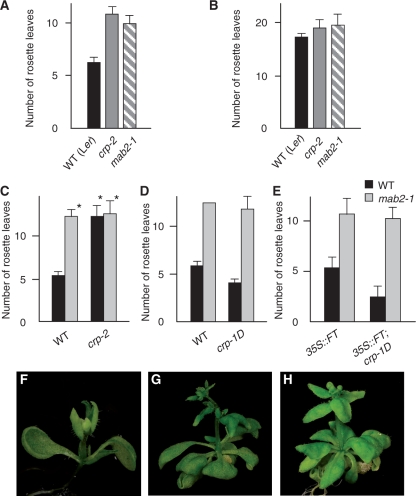Fig. 5.
Effect of the mab2 loss-of-function mutation on the flowering time of crp mutants. (A and B) Flowering time of crp-2 and mab2-1 mutants under long-day (A) and short-day (B) conditions. (C) Flowering time of the crp-2 mutant with a wild-type MAB2+ or mab2 loss-of-function allele. There is no statistically significant difference (Student’s t-test, P > 0.5) among genotypes marked with an asterisk. (D) Flowering time of the crp-1D mutant with a wild-type MAB2+ or mab2 loss-of-function allele. (E) Flowering time of 35S::FT #1-5L/−; crp-1D L/+ plants with a wild-type MAB2+ or mab2 loss-of-function allele. (F–H) Effect of mab2-1 on the flowering phenotype of crp-1D plants. 35S::FT #1-5L/−; crp-1D L/+ (15 d old) (F), 35S::FT/−; crp-1D/+; mab2-1 (20 d old) (G) and crp-1D L; mab2-1 (30 d old) (H). Plants were grown under long-day conditions. In A, C and E, the numbers of rosette leaves are the average of at least 10, six and five plants, respectively. B and D include genotypes with two or three plants. Error bars in A–E indicate the SD, except for mab2-1 (n = 2) in D (left gray bar). Additional data and statistics of the data are summarized in Supplementary Tables S2, S9 and S10.

